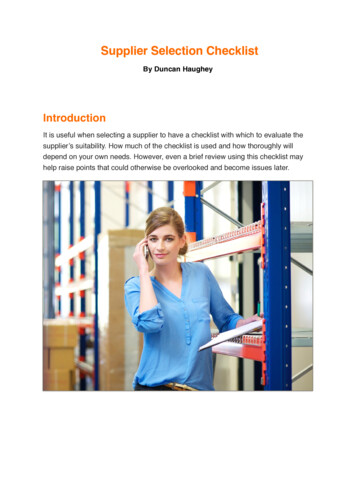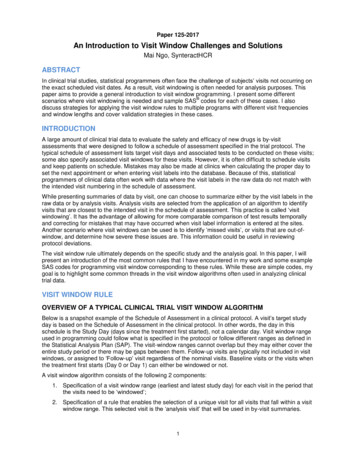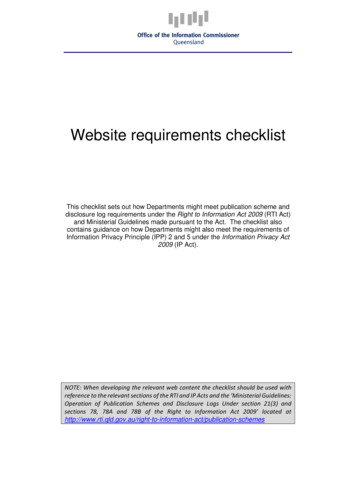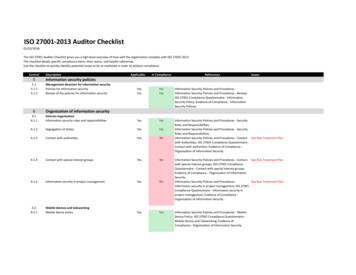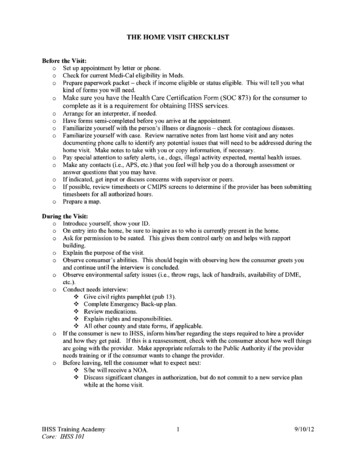
Transcription
THE HOME VISIT CHECKLISTBefore the Visit:o Set up appointment by letter or phone.o Check for current Medi-Cal eligibility in Meds.o Prepare paperwork packet - check if income eligible or status eligible. This will tell you whatkind of forms you will need.o Make sure you have the Health Care Certification Form (SOC 873) for the consumer tocomplete as it is a requirement for obtaining IHSS services.oooooooooArrange for an interpreter, if needed.Have forms semi-completed before you arrive at the appointment.Familiarize yourself with the person's illness or diagnosis - check for contagious diseases.Familiarize yourself with case. Review narrative notes from last home visit and any notesdocumenting phone calls to identify any potential issues that will need to be addressed during thehome visit. Make notes to take with you or copy information, if necessary.Pay special attention to safety alelis, i.e., dogs, illegal activity expected, mental health issues.Make any contacts (i.e., APS, etc.) that you feel will help you do a thorough assessment oranswer questions that you may have.If indicated, get input or discuss concerns with supervisor or peers.Ifpossible, review time sheets or CMIPS screens to determine if the provider has been submittingtimesheets for all authorized hours.Prepare a map.During the Visit:o Introduce yourself, show your ID.o On entry into the home, be sure to inquire as to who is currently present in the home.o Ask for permission to be seated. This gives them control early on and helps with rapportbuilding.o Explain the purpose of the visit.o Observe consumer's abilities. This should begin with observing how the consumer greets youand continue until the interview is concluded.o Observe environmental safety issues (i.e., throw rugs, lack of handrails, availability of DME,etc.).o Conduct needs interview:.:. Give civil rights pamphlet (pub 13) . :. Complete Emergency Back-up plan . :. Review medications . :. Explain rights and responsibilities . :. All other county and state forms, if applicable.o If the consumer is new to IHSS, inform him/her regarding the steps required to hire a providerand how they get paid. If this is a reassessment, check with the consumer about how well thingsare going with the provider. Make appropriate referrals to the Public Authority if the providerneeds training or if the consumer wants to change the provider.o Before leaving, tell the consumer what to expect next:.:. S/he will receive a NOA . :. Discuss significant changes in authorization, but do not commit to a new service planwhile at the home visit.IHS S Training AcademyCore: IHSS 10119110/12
Best Practices (not in regs):o View all rooms in the home utilized by the consumer (if reassessing, check that assessed choresare being completed).o Note DMEs that will improve the safety of the client.o Suggest/make referrals as needed.o Assess the need to make referrals.Cleanse your hands immediately following every visit.Take precautions while transporting forms that contain consumer information per your county's policy.IllS S Training AcademyCore: IHSS 10129/1 0112
PERSONAL SAFETY TIPS FOR HOME VISITINGGeneral Tips:Pay attention to intuitive feelings.Be alert to your surroundings.Anticipate potential problems.Keep a list of your credit card numbers in a safe place.Carry only enough money to get through the day.Maintain your car;. Make sure you have enough gas.Carry a cell phone.Obtain any history of clients to be visited (i.e., chemical abuse, history of violence, criminalactivity, non-compliance with medication, violent or criminal family members, etc.)IAppearance is Everything:Dress practically. Wear clothing that allows you to move freely and wear comfortable walkingshoes.Avoid wearing expensive jewelry or accessories.Walk with confidence and purpose - head up, eyes forward.Keep your purse or wallet out of sight or lock them in the trunk. Keep car keys handy at alltimes.IProtect Your Health:ILearn about any situations that might jeopardize your health.Use universal health precautions.Carry sanitary wipes or antibacterial lotion.Know Where You Are Going:IPlan your route and carry maps.Learn about the neighborhood you will be visiting.Go with assistance if you're concerned (law enforcement or another social worker).Consider asking law enforcement to do a "Welfare Check".Visit areas of high-risk early in the day.Let people know where you are going: Give location, name of consumer, license plate of yourvehicle, and time you are expected to leave location with a supervisor or co worker.Don't carry any weapons. (In case of emergency, pens, clipboards, keys, etc. could be used forprotection.)Have supervisor or co-worker make a safety check phone call every 10-15 minutes.Before You Get Out of the Car:ICheck out the neighborhood as you drive in.IDrive around the block, try and see what is happening behind the house.If you don't feel safe, don't get out of the car. Leave.Park in a visible area as close to the consumer's residence as possible.Think about an escape route.IHS S Training AcademyCore: IHSS 1013
Getting to the Door:Lock your car.Be prepared to drop items you are carrying.Do not stop to speak to strangers. If you must respond, keep walking.Before entering a fenced yard, make noise to see if any animals are present.Don't enter the home if an animal threatens your safety (ask the consumer to secure the animal).After knocking, stand away from the door and to one side if possible - hinge side is best forproviding protection.In an elevator, stand near the control panel.Leave the area if your instincts tell you to.IEntering the Consumer's Home:Fo11ow consumers up the stairs. Do not let them behind you.Scan the inside of the consumer's home before entering.Once in the home, look around for signs of dog. Ask if the dog is safe/friendly if it is locked up.Don't enter the home if you suspect that the consumer is under a chemical influence.Try to make eye contact with anyone present.Sit near an exit door and be prepared to leave at any sign of danger. Do not allow anyonebetween you and the door.IAcknowledge Anger if it Exists:IPeople may escalate their anger if they aren't sure you know it exists.IRemain calm, objective and in control.Avoid interviewing hostile people in the kitchen (knives).Use a problem-solving approach.After the Visit:IWhen returning to your car, have a co-worker or supervisor on the phone until you are in the carand on the road.Have your keys in your hand when returning to your car.Check the inside of your car before getting in.Document any unusual or unsafe conditions.Discuss concerns with your supervisor.Develop strategies to address concerns for future visits.Vehicle Safety:Always check your tires and gas gauge before setting out on a visit.Park in a well lit area.Keep doors and windows locked.Do not leave anything on the seat of the car. Put all items in a trunk prior to arriving at yourdestination.IIf a Crisis Arises:Talk softly.Try to keep calm.Tell the person you are expected elsewhere or a co-worker has been instructed to call for help ifyou are not out at an agreed time.IIHS S Training AcademyCore: IHSS 1014
SOME SUGGESTIONS ABOUT DOGSWhat to do when approached by or you approach a strange dog:.:. :. :. :. :.Treat all breeds the same - all dogs bite .NEVER look the dog in the eye .NEVER pat the dog on top of its head .Don't give the dog undue attention .Be aware of your body language and voice tone(do/say nothing threatening) . :. Older dogs are more likely to bite . :. NEVER turn your back on a dog or run away (walk slowly).What to do when approached by an apparently vicious dog:.:.:. :. :. :. :.Don't get out of your car if you're already in it.Do nothing that seems threatening to the dog. This includes spraying with pepper spray .Throw dog treats and/or tennis balls to distract the dog .Protect your face and neck. Do not play dead .Larger breeds have larger mouths .Ifbitten, go to your doctor. Bites must be reported to the Humane Society.IHS S Training AcademyCore: IHSS 1015
IllS S Training AcademyCore: IHSS 1016
THE INTERVIEWInterview SkillsEstablishing Rapport - Warmth, Empathy and GenuinenessWarmth - conveys a feeling of interest, concern, well-being and affection to another individual. Itpromotes a sense of comfort and well-being in the other person. Examples: "Hello. It's good to meetyou." "I'm glad we have the chance to talk about this." "It's pleasant talking with you."Empathy being in tune with how a consumer feels, as well as conveying to that consumer that youunderstand how she/he feels. Does not mean you agree. Helps consumer trust that you are on theirside and understand how they feel. It also is a good way to check to see if you are interpreting whatyou observe correctly. Mirroring non-verbal can send empathetic messages. Example of leadingphrases: "My impression is that. . " "It appears to me that. . " "Is what you're saying that. . " "Youseem to be . " "I'm hearing you say that. . "Genuineness - means that you continue to be yourself, despite the fact that you are working toaccomplish goals in your professional role. Being yourself and not pretending to be something youare not conveys honesty and makes consumers feel like you are someone they can trust.General Interviewing SkillsBefore the Interview - review the case and think about the possible things you will need to assess withthis consumer. Are there any cues from the initial information that help you to come up with an approachto the interview? For example: Is the consumer a native English speaker, blind, mentally-impaired?Pre-interview Planning - Be PreparedReview case file and gather cues about consumerFormulate questions based on cuesPlan interview approachMeeting the Consumer - Establish RapportIntroductions should be formal and cordialSmall talk to get the conversation goingPay attention to verbal and non-verbal cuesBegin Assessment Interview - Explain ProcessExplain purpose of interviewExplain your role to the consumerAsk the consumer for feedback do they understand the process and purpose?Concluding the InterviewClarify - Next stepsExplain - Additional paperwork needed before authorization of servicesDiscuss Notification process of authorized hoursAnswer Questions the consumer may haveIHS S Training AcademyCore: IHSS 10179110112
The Interview: Choosing the Right QuestionsDirect or Closed-ended QuestionsAre questions that seek a simple "yes" or "no" answer.Specifically ask for information. For example: "Are you coming tomorrow?" or "Do you eat threetimes a day?"These questions do not encourage or allow for an explanation of why the answer was chosen, or foran elaboration of thought or feeling about the answer.They can be leading -they ask a question in narrow terms such that they seem to be "hinting" at theanswer.Open-ended QuestionsCannot be answered by yes or no.These questions begin with 'who', 'what', 'where', 'when' or 'how.'They give consumers more choice in how they answer and will encourage them to describe the issuein their own words.Open-ended questions seek out the consumer's thoughts, feelings, ideas and explanations for answers.They encourage elaboration and specifics about a situation. For example: "How are you able to bathyourself?"Indirect QuestionsAsk questions without seeming to.They are not stated as a question.In these the interviewer is asking a question without stating it in question format. For example: "Youseem like you are in a great deal of stress today."IHS S Training AcademyCore: IHSS 10189/10/12
Open-ended Questions for InterviewsOpen-ended questions cannot be answered by yes or no. These questions usually begin with "who","what", "why", "where", and "when."1.How have you been managing at home since I saw you last/since you got home from the hospital?2.What do you need in the way of help right now?3.Let's talk about things you are able and not able to do.4.Help me understand .5.What do you mean6.Would you tell me more about. . ?7.What else can you tell me that might help me understand?8.Could you tell me more about what you're thinking?9.I'd be interested in knowing .10.Would you explain . ?11.Is there something specific about that you are asking for?12.Would you explain that to me in more detail?13.I'm not certain I understand . Can you give me an example?14.I'm not familiar15.What examples can you give me?16.You say that you're not able to [cook/bathe/ . . How have you been managing [yourmeals/bathing/. . ]?17.When you say18.I'd like to help you get the best possible service; what more can you tell me that will help meunderstand your need?, can you help me to understand?--7what do you mean?Adapted from: Understanding Generalist Practice, Kirst-Ashman and Hull Nelson-Hall PublisherIHS S Training AcademyCore: IHSS 10199/10/12
The Interview: Other Assessment CuesNon-verbal Assessment Cues:Your Body Speaks Your MindBetween 60-80% of our message is communicated through our body language, only 7-10% isattributable to the actual words of a conversation.Whenever there is a conflict between verbal and non-verbal, we almost always believe the non-verbalmessages without necessarily knowing why.Eye ContactIt is important to look a consumer directly in the eye. Hold your head straight and face the consumer.This establishes rapport and conveys that you are listening to the consumer. This is not staring, but beingattentive. However, be conscious of cultural differences and respect them.Facial ExpressionsThese are the strongest non-verbal cues in face-to-face communication. Be aware of your own non-verbal- what are my habits that could be interpreted wrongly. Make certain that your facial expressions arecongruent with your other non-verbal behavior. (Crossing arms, hands on hips, other . not portrayingyour interest) What do I see in the other person's face? If unclear, ask for interpretation.Body PositioningPosture, open arms versus crossed. When interviewing consumers look for cues in their body positioning,and be aware of your own. Sitting in an attentive manner communicates you are interested.Environmental Cues:Discrepancies between the way the environment looks and what consumer reports as service needs.Importance of observations (Le., house condition, cleanliness of consumer, tour house, etc.).Sensory Cues:Data obtained by smelling.Tactile information sticky floors, surfaces.IHS S Training AcademyCore: IHSS 101109110112
The Interview: Clarifying InformationIt is important to probe for details and clarify information in order to get the best outcomes from theinterview. Look for:1. Conflicting information. What is observed is not consistent with information givenFor example, consumer says she can't feed herself but she has been knitting, an activity thatdemonstrates manual dexterity. Perhaps the consumer's difficulty is in lack of strength; probingquestions would be needed to tease out the basis of the statement that she cannot feed herself.Also, consider good days versus bad days. You may be seeing the consumer whose condition andabilities fluctuate. What the consumer says is inconsistentFor example, he says that he has no trouble bathing himself and he tells you that he is unable towalk without someone's constant assistance because he can't hold onto the handrails of a walkeror a cane and he's unsteady on his feet. Perhaps the consumer who is at risk of falling isextremely modest and doesn't want anyone to see his naked body. What the consumer says and the family says are in conflict.For example, the consumer says that he needs no help in dressing. The daughter with whom helives and who is also his primary caretaker says that she dresses him every day. Probingquestions are needed to determine whether the daughter is dressing her father because it's fasterthan to let him do it himself or if he is unable to dress himself. Issues to be considered wouldinclude his ability to reach, balance when standing, and perform tasks that require manualdexterity such as buttoning and zipping.2.Unrealistic expectations of the program.For example, the consumer had fallen and broken her hip. When she fell, she had lain on the floor for7 hours until a neighbor heard her calling for help. The consumer just returned home from a rehabfacility for therapy following hip replacement. She wants round-the-clock care so that if she fallsagain, she will get immediate help. Her concerns are understandable, but not within the Programscope. An alternative would be to make referrals to organizations that can provide her with a panicbutton so that she can summon assistance in the event of another fall.3.Safety issues.For example, a consumer says she is independent bathing. Thought she's unsteady on her feet, shesays that she holds onto the towel rack to aid in stability. You look in the bathroom and confirm thatwhat she's using to stabilize her is not a properly installed grab bar but a towel rack that is starting tocome loose from the wall behind the bathtub. She needs help getting into and out of the tub and agrab bar and shower bench. If she discusses this with her physician and obtains a prescription forthese items, it's possible that Medi-Cal will pay for these safety devices. Without assistance into andout of the tub, she's at risk of falling.How to Probe to Clarify InformationWhen probing to clarify information the goal is to check that you have heard the consumer correctly, youare clear on the details of the information, and you have a complete picture of the situation. The followingare a few methods that can be used to verify information and to decrease the risk of misunderstandingwhat the consumer has said.IllS S Training AcademyCore: IHSS 101119110112
1. Paraphrasing - Feedback the consumer's ideas in your own words. For example, the consumer saysthat he doesn't go to church anymore because he can't be far from a toilet after taking his diuretic.You say, "I see, you take a diuretic in the morning and have to be close to the toilet. How long doesthat last?"2.Stating your observations - Tell the consumer your observations about his behavior, actions andenvironment to find out if they are on target. For example, if you see that he can't get out of the chairwithout help, say so.3. Demonstration - Rave the consumer to show you an activity. For example, you wonder how well theconsumer transfers. You ask the consumer to show you the apartment. That gives you theopportunity to see the consumer transfer without specifically asking the consumer to demonstrate.4.Asking clarifying questions - These questions are questions that get to details. For example: "What do you mean by that? You said that you were tired a lot; tell me what the mean to you." Ifthe consumer doesn't explain what they mean it is open to interpretation. "Could you explain that, tell me more about that?" "I'm not sure I understand." The simply directs the consumer's comments by letting him knowyou do not understand.IRS S Training AcademyCore: IHSS 101129/10/12
The Interview: Handling Difficult SituationsMost of the time the interview will go smoothly, but there are times when things will come up that willmake getting good information more difficult. Here are some hints to help make each situation moresuccessful.1. The angry consumer - It is best to try to handle the anger at the beginning of the interview. Thisshows the consumer you care, and aren't there just to get your agenda accomplished. It never helps toignore the anger; it will be a constant barrier to getting useful information. Acknowledge the anger by gently confronting the consumer by saying something like, "You seemvery upset and I am not sure why. Could we talk about what is upsetting you before we start?" To get an angry person to open up explain (or re-explain) your purpose and that you need them tohelp you so you can best understand their needs and how the program can help them.2. The consumer who is very sad / grieving - If the consumer is overcome by sadness and starts to cry. Don't ignore or pretend they are not upset, crying. In some cases, it may not be obvious about thereasons for the sadness/grief, which may not become apparent until you ask a specific questionthat triggers the grief/sadness. Be direct but polite and sensitive. Let them talk briefly about thereason for the sadness/grief. You may say something like, "I'm sure that is very difficult foryou", or "I'm sorry." Try to be reassuring and let them know it is safe to express their feelings. A comment like, "It isOK to cry; we all cry," or, "I understand," can be effective. Validate the situation by saying something like, "I have had other consumers who have the samereaction. It is hard." or, "These are difficult issues you're are dealing with, it is very normal." If the consumer is too distraught about a recent death or other stressful event to focus on theissues you need to discuss for your assessment, it might be most appropriate to offer to reschedulethe interview.3. The consumer who rambles without focus - These consumers often want to tell long stories and oftenhave a difficult time getting to 'the point'. Remind the consumer of the goal of the interview. "That is very interesting Mrs. Jones, I reallyneed to find out the details of how you get along each day so that I can help you get the servicesthat you need. Can you tell me specifically how you prepare your meals?" Rephrase the question in a more closed ended question, "I understand there have been manyissues with your personal care. Do you need help with bathing?", if so you can then probe forspecifics.4.The consumer who answers with only a word or two This can be very difficult because withoutinformation it is hard to get a good picture of the consumer's need. Use open ended questions to try to get the consumer to give you a better picture. Ask the consumer to paint you a picture of their day, "tell me what your day normally looks like."It is difficult to answer a question like this with one or two words and may get them to open up,or will allow you opportunities to probe for further information.5. The consumer who is embarrassed Some of the questions asked during the interview may beembarrassing to consumers. Especially those related to bowel and bladder care, and menstruation. Reassure the consumer and acknowledge these may be embarrassing questions but that you needthe information so they can get the assistance they need. "I know this may be embarrassing foryou but I need to find out exactly what your needs are. Now you had said you have problemsgetting around. I'm wondering if that makes if difficult for you to get to the bathroom in time andcauses you to have accidents."IHS S Training AcademyCore: IHSS 101139/10/12
6. Communication blocks: Hearing difficulties a Ask the consumer if they have a hearing aide. If they do check to see if it is in and if it is on.If the consumer cups his/her hand over the ear, the hearing aid will whistle if it is turned on.a Talk slowly without jargon.a If the person doesn't seem to understand, paraphrase yourself.a Ask if one ear is better that another and position yourself on that side.a You may need to follow up with a family member to get clarification of information. Language barriers a If they understand and speak some English make sure you go slowly, give them plenty oftime to think of their answers and do not compound your questions.a Follow State regulations (MPP 21-115) and county procedures to arrange for an interpreter ifthe consumer does not speak English and you do not speak his/her language.IllS S Training AcademyCore: IHSS 101149/10/12
COMMUNICATING IN DIFFICULT SITUATIONS1. Listen for full understanding of the person's perspective. Allow them the opportunity to give you aclear picture of what they are trying to say.2. Put the person at ease using non-verbal cues that show interest and concern.3.Take the time you need to really understand the situation. In the long run, spending a few moreminutes now will save time in avoiding conflict.4.Respond to concerns the consumer may have in an affrrming manner. Restate their concerns in a waythat shows you have heard their issues.5. Focus on the overall goal of the situation. Avoid personalization of the issues. Keep the conversationprofessional.6.Understand what you do Today will have an Effect on Tomorrow. The more effective you are indealing with the issue at hand, the less the issue will grow and consume your energies.IllS S Training AcademyCore: IHSS 10115
HANDLING HOSTILITYThe following are suggestions for handling consumer hostility:1.Don't get angry or defensive. Recognize your own reactions. Remember that this is a professional,not personal, issue.2.Don't patronize or lecture. Saying things such as, "why don't you just calm down" will onlyescalate the problem and is disrespectful to the consumer.3.Allow the consumer to voice hislher concerns. Respond with acceptance and understanding. Beempathetic. Listen to understand the situation from the consumer's perspective.4.Be positive - don't attack them. Show them respect for their discomfort.5.Greet anger with calmness - set the mood for calm discussion and resolution.6.Understand the facts regarding the situation that is upsetting the consumer. If you don't have thefacts, state what you will need to find out and when you will get back to them.7.Focus on present and future. Avoid allowing the consumer to get stuck in the past. Emphasizewhat can be done positively in the future, not what has happened in the past.8.Ask questions "How can I help?" Often the consumer knows what they want from you. If youunderstand their wants you will be able to discuss future possibilities with that in mind.9.Summarize for clarification and understanding.10.Be honest about your next steps. If you can't fix the problem outright, don't make promises thatyou cannot keep. If there are consequences to the behavior, let the consumer know.Adapted from: Understanding Generalist Practice, Kirst-Ashman and HullNelson-Hall Publishers and Connecting with self and others, Sherod Miller et.aLInterpersonal Communications Programs, Inc.IHS S Training AcademyCore: IHSS 10116
THINGS TO CONSIDER WHEN DEALING WITHSOMEONE WHO IS HOSTILE1. Try to evaluate as honestly as you can by reasoning with yourself whether his/her anger is justified.2. Put hostile people in perspective. You are probably nothing but an afterthought to them, so don't taketheir antics personally. They're not concerned about you because they're too busy worrying aboutthemselves.3. Take your pick - positive or negative. You cannot concentrate on constructive, creative alternativesor solutions while you cling to negative feelings. Vent your emotions to a fellow worker or yoursupervisor and cool off. Think about the result you really want, the consequences or outcome thatwill benefit the consumer the most.4. Don't expect hostile people to change. They will not, and in a way that is good because theirbehavior is predictable. They may not change but by choosing a better approach you can change theoutcome.5. Learn to respond as well as listen. Ask questions instead of making accusations. If you let otherssave face, you give them room to change their minds.6. Request feedback. Use open-ended questions to let emotional people vent their feelings before youtry to reason with them and explore options.7. Be straightforward and unemotional. The more you remain calm and matter-of-fact, the sooner yougain another's confidence. People want to feel you are leveling with them, that they can trust you.Remember that respect from other begins with self-respect.8. Be gracious. Someone else's rudeness does not give us the right to be rude. Treat the other with thekindness you would like to be shown and allow them to feel important. When our own egos arehealthy, we are rich; we can afford to be generous.IllS S Training AcademyCore: IHSS 10117
SHARED LIVING PRORATION CHARTNot prorated - MPP 30-701(s)(2) provides that a shared living arrangement does not exist if consumer resides only with AlA SpouseSpouse andOthers, ornot AlASharedLive-in ProviderConsumer movesin with relative toreceive mssLandlord/Tenant(Consumer isTeLandlord/Tenant(Consumer isLandlord)Follow Shared Living rulesMPP 30-763.31Follow Shared LivingrulesMPP 30-763.32Follow Shared LivingrulesMPP 30-763.32Follow Shared LivingrulesMPP 30-763.32Follow Shared LivingrulesMPP 30-763.32Assess need in room(s) used exclusively byconsumer.Noneed assessed in rooms used exclusively by others. Determine consumer's share of rooms usedmcommon.MPP 30-763.31 No need assessed in rooms used solely byprovider. Assess need in rooms used by consumer. Determine consumer's share of rooms usedin common.MPP 30-763.471Need is assessed only in room used solely byconsumer.MPP 30-763.43Need is assessed only on the living area usedsolely by the consumer.MPP 30-763.421Need is assessed for all living areas not usedsolely by the tenant.MPP 30-763.422When need is met incommon, dividehousehold need by allhousemates involved.MPP 30-763.32When need is met incommon, dividehousehold need by allhousemates involved.MPP 30-763.32When need is met incommon, dividehousehold need by allhousemates involved.MPP 30-763.32When need is met incommon, dividehousehold need by allhousemates involved.MPP 30-763.32Prorate if provider andconsumer agree and needmet in common.MPP 30-763.471Prorate if provider andconsumer agree and needmet in common.MPP 30-763.471Prorate if providerand consumer agreeand need met incommon.MPP 30-763.471Prorate if providerand consumer agreeand need met incommon.MPP 30-763.471II IFollow Shared LivingFollow Shared LivingFollow Shared Living Follow Shared LivingrulesrulesrulesrulesMPP 30-763.32MPP 30-763.32MPP 30-763.32MPP 30-763.32Follow Shared Living rules taking into account any services landlord is obligated to perform under therental agreementMPP 30-763.32: 30-763.421Follow Sha
Sep 10, 2012 · THE HOME VISIT CHECKLIST Before the Visit: o Set up appointment by letter or phone. o Check for current Medi-Cal eligibility in Meds. o Prepare paperwork packet - check if income eligible or status eligible. This will tell you what kind of forms you will need. o Make sure you have the Hea



